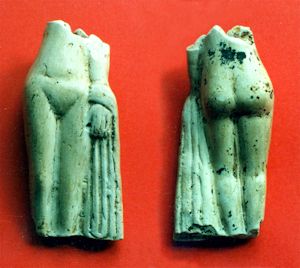
A very distinct inter-cut cluster of round-to-oval-shaped pits (5147, 5156, 5158, 5177, 5206, 13366, 13399, 13401) is located immediately to the north-east of the temple (Building 52), a short distance from its entrance (Figure 78). All are between 1.0-2.5m diameter, flat-bottomed, and rarely deeper than 0.45m. All are dated by their contents to the first half of the 2nd century AD and pit 5147 (fill 5146) contains KPG21 which is dated to c. AD 120-125. The eight pits are all cut into the north-east corner of the foundation of former trapezoidal Building 35, clearly showing that it is demolished by the early 2nd century. It is possible that some of the unphased, but broadly Roman, post-holes to the north and east form an enclosing fence around this area of pitting, or even constitute minor depositional activity in their own right alongside (e.g. 5319, 5315, 5328, 5295, 5285, 5249, 5251, 5253: parts of miscellaneous groups 1137/3029/5008).

Like the Period 3A pit 13892 to the rear of the temple, it is the location of these features that is of primary importance in the recognition of their probable 'ritual' function. It seems that the pits are contemporary with the use of the second phase of the temple (Building 52); being located immediately alongside it, but carefully positioned so as not to encroach upon its access. Given the northern and eastern limits of this cluster, it is possible that they were even positioned in relation to the plan of the portico of earlier Building 35. This pitting continued into the 3rd century, as evidenced by Period 4 pit 5145, the latest in the inter-cut sequence (Group 430).

Although the spatial distribution of these pits is striking, their contents display a less obvious, though still discernible, trait of structured deposition. Finds assemblages largely comprise modest assemblages of pottery, tile, and bone that are not particularly different from those of Period 3 pits elsewhere across the settlement. The most obvious item of religious significance is the pipeclay Venus figurine (SF4717) in pit 13366 (Figure 81). Pit 5147 contains an iron knife and bone needle and pit 5158 a bone hairpin, all of which could constitute the offering of personal items. Perhaps most importantly, the remains of only older sheep have been identified in pits 5147, 5156, 13366, 13399 and 13401. Furthermore, chicken bones are present in pits 5147 and 13366. Thus, the deposition of votive, even sacrificial, material seems reasonably clear-cut.
Further consideration of their function as votive pits within the wider religious practice of the temple complex is presented in Atkinson and Preston (2015, Chapter 6.
Internet Archaeology is an open access journal based in the Department of Archaeology, University of York. Except where otherwise noted, content from this work may be used under the terms of the Creative Commons Attribution 3.0 (CC BY) Unported licence, which permits unrestricted use, distribution, and reproduction in any medium, provided that attribution to the author(s), the title of the work, the Internet Archaeology journal and the relevant URL/DOI are given.
Terms and Conditions | Legal Statements | Privacy Policy | Cookies Policy | Citing Internet Archaeology
Internet Archaeology content is preserved for the long term with the Archaeology Data Service. Help sustain and support open access publication by donating to our Open Access Archaeology Fund.